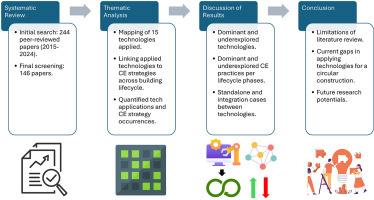The world population has doubled in the last five decades. Forecasts suggest that global consumption of natural resources could increase by 60% by 2060 compared to 2020 levels [1]. This increase in resource extraction is associated with approximately 50% of the impacts of climate change and over 90% of the biodiversity loss observed in recent decades [2]. The construction sector bears significant responsibility for this environmental impact, as it accounts for around a third of global resource consumption and generates significant waste through construction and demolition work [3]. In 2023, greenhouse gas emissions from materials production accounted for 23% of total emissions, up from 15% in 1995, with around 80% of these emissions associated with materials used in industrial and construction products [2]. The International Resource Panel report on resource efficiency suggests that implementing effective resource efficiency strategies could potentially reduce emissions from the housing sector by up to 70% by 2050 [2].
In response to these challenges, the circular economy (CE) has emerged as a transformative approach that emphasizes the continuous use of resources while aiming to eliminate waste. According to Circle Economy, eight key elements, including “Extend Lifespan,” “Use Waste as a Resource,” “Design for the Future,” “Integrate Digital Technology,” and “Strengthen and Promote Knowledge,” form the backbone of CE strategies [4]. Applied to the construction context, CE principles promote the preservation of the highest value of building components through continuous use, repair and recycling cycles to reduce waste and greenhouse gas emissions [5]. Current analyzes indicate that CE concepts have gained significant momentum in the construction industry since 2017 [6].
Driving this change are digital technologies, which have proven to be key enablers for the implementation of CE practices throughout the building life cycle. The research by Gasparri et al. deals with the challenges of CE in the construction industry. points to the urgent need for integrated and innovative design approaches and calls for greater digitalization of construction processes, particularly in the management and use of construction data [7]. The interface between digital technologies and circular economy in construction has been the subject of several systematic literature reviews. For example, Banihashemi et al. (2024) examined the challenges of technological integration in the built environment [8]while Çetin et al. (2022) examined practical implementation issues using case studies of Dutch social housing organizations [9]. Samuelson and Stehn (2023) analyzed the requirements and acceptance factors for digital transformation in construction [10]. Despite these valuable contributions, the literature continues to have significant gaps: most reviews focus on isolated technologies or CE strategies, lack a systematic framework for mapping technologies to CE strategies, focus on selected life cycle phases rather than providing a holistic analysis, and rarely identify unexplored or mature technologies nor do they provide in-depth reviews Conduct gap analyzes to identify avenues for future research.
To address these shortcomings, this systematic literature review provides the first comprehensive mapping framework that systematically connects 15 digital technologies with 25 CE strategies across five phases of the building life cycle. In contrast to previous reviews, this study provides a holistic assessment of technology maturity, identifies under-researched areas, and provides strategic insights for future research directions. It contributes to advancing circular construction practices by developing a comprehensive technology-strategy matrix based on analysis of 146 articles from 244 initially identified sources, systematically distinguishing mature technologies from underused ones, uncovering patterns of strategic emphasis and neglect within CE strategies, and providing a structured foundation for further circular development Construction practices delivered through strategic integration of digital technologies.
